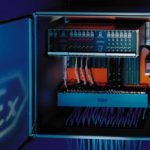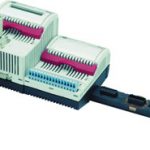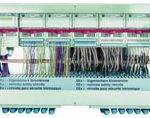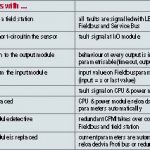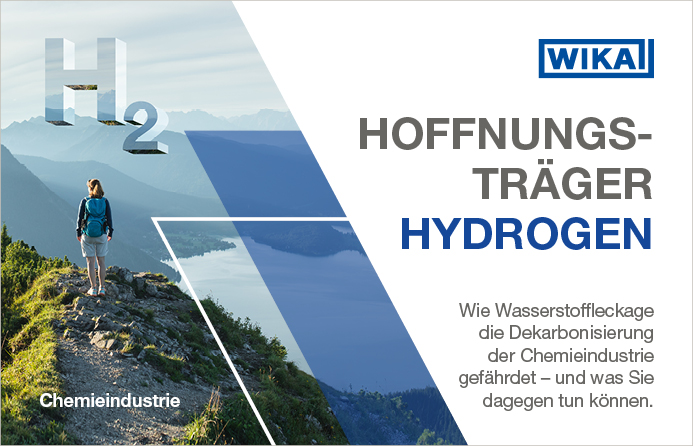No additional protective devices have to be installed if remote I/O technology is used in hazardous areas. A field bus connects to the automation system, and intrinsically safe sensors and actuators can be connected directly to the remote I/O.
Michael Hagen
The intrinsically safe type of explosion protection has proved its value worldwide in providing explosion protection for process plant automation technology. Three different technologies are available today, suited to most applications:
• Safety barriers (Zener barriers):
Viewed historically, barriers are the classic Ex i interface modules. They are cost-effective, have a simple design, do not need any power supply and hence are highly available. An essential prerequisite for their use is high-quality equipotential bonding.
• Ex i disconnector modules with electrical isolation:
This technology provides isolation between the intrinsically safe and non-intrinsically safe circuits. In practice this is achieved by means of transformers, optocouplers or relays. Since the circuits are usually not connected to earth potential, they have a high immunity to interference. The versatile interconnection options make engineering easier, for example in looping 4 to 20 mA signals through several units.
• Remote I/O with Ex i inputs and outputs:
No additional protective devices are install-ed here, as with safety barriers or Ex i disconnector modules. Instead, this technology merges the I/Os of the automation system into one unit with the corresponding Ex i interface. A field bus connects to the automation system, and intrinsically safe sensors and actuators can be connected directly to the remote I/O. Remote I/Os are preferably used locally, in other words in Zone 1 or Zone 2 hazardous areas; field devices can therefore be connected via short cables.
The first generation
In the early eighties the FM 100 field multiplexer was developed for the Teleperm M process control system, suitable for installation in Zone 1. A remarkable achievement of engineering but with no success on the market. After 1987 this idea was developed further with the ICS MUX Fieldbus system for Zone 1. A new power supply concept in the field stations ensured that all electronic subassemblies could be replaced in the hazardous area without interrupting operation, an important feature in view of the tough demands of process technology. Most importantly, this system was first used where new technology could best demonstrate its advantages:
• no space in the control room for extensions (chemical industry),
• existing cable ducts full (refineries),
• weight of cables expensive (offshore platforms).
Control system manufacturers meanwhile also contribute to its acceptance, since they have recognised the necessity of open systems. The second generation, the I.S.1 remote I/O system for applications in hazardous areas (Fig. 1), is now available.
The components of I.S.1
The CPU and power module contains the connections for the various field buses (Fig. 2). A power supply for the I/O modules, including Ex i field circuits, is also incorporated. The integrated display can show the condi-tion of a station as well as information about single modules and signals. The service bus interface permits configuration, parameterisation and complete testing of a field station. The I/O modules can be plugged into any free position – their number is restricted only by the power supply. The inputs and outputs are intrinsically safe, and the technical data is matched to the sensors and actuators normally used in process technology. The I/O modules have 4, 8 or 16 channels and are designed for analogue and digital inputs and outputs as well as for temperature sensors and frequency transmitters. HART modules round off the range. The busbar intercon-nects the modules electrically. It can be mounted on any standard 35 mm rail. The cross-connection contains data, addresses and the complete power supply for the system. Several sections can be plugged together to extend the system. All electrical connections (power supply, field bus, field devices) are pluggable and equipped with a locking de-vice. This ensures rapid and reliable module changing.
System structure
The ability to mix installation types is important for practical application. Hence, the busbar and the I/O modules are designed so that they can be used in both hazardous (zone 1 and 2) and safe areas (Fig. 3). This reduces the number of different units, which must, for example, be stored as spare parts. Only for the CPU & power module is a special, enclosed version necessary for installation in Zone 1.
The design consists of a base, which is plugged into the busbar, and a flameproof, enclosed electronic module, which can be changed during operation in Zone 1. Compared to conventional field wiring, I.S. 1 cuts costs effectively. Planning and installation are simplified by the omis-sion of Ex i disconnector modules, terminals and cables. I.S.1 field stations replace the formerly usual terminal boxes in the field (intelligent field distribution). The number of units which have to be provided in total is significantly reduced. The high number of channels of each I/O module also reduces the cost per signal.
Installation in process plants
In addition to explosion protection, there are further demands that have to be satisfied by remote I/O systems as a result of the special conditions and constraints of processing plants, such as communication with HART transmitters and actuators, high availability, in particular with continuous processes, short repair times and simple extendibility. A comprehensive redundancy design ensures that even if module faults occur, their effects are restricted to a minimum. The internal I.S.1 bus has, for example, an essentially redundant design; a defective I/O module cannot, therefore, lead to the failure of a complete field station. The CPU and power module, the central module of a field station, can be very rapidly replaced in the event of a fault. The highest availability can be achieved with a redundant CPU and power module (hot standby).
Typical plant structures also contain ordinary, non-explosion protected sensors and actuators as well as intrinsically safe ones. An I.S.1 field station can of course be designed for non-explosion protected applications as well. One interesting option lies in the fact that I/O modules for Ex i signals can be combined in a field station with I/O modules for non-Ex i signals. Further savings in space and materials can be achieved in this way.
The future belongs to remote I/O
Several points contradict the argument that remote I/O will only be needed for a transitional period until all sensors and actuators can be driven directly on the field bus. Connecting simple binary devices, such as contacts and solenoid valves or temperature sensors, to remote I/Os is much more cost-effective in comparison with bus-capable devices. Furthermore, remote I/O already offers integration of HART communication and thus provides the basis for central control of the field device database. OPC interfaces and ActiveX technology will ensure that remote I/O is even better integrated into the structure of automation systems in the future. Ethernet with TCP/IP will also be increasingly used in industrial automation. Remote I/O is ideal for defining an interface between field devices and Ethernet. Finally, one further perspective should not be omitted: the trend towards distributed open and closed-loop control functions. Function blocks, such as those processed today in PLCs, distributed control systems or PCs, can alternatively be integrated into remote I/O.
R. Stahl
Fax: ++49/7940/1 73 33
Further information cpp-226
Unsere Whitepaper-Empfehlung
Wasserstoff gilt als Schlüssel für die Dekarbonisierung der Chemieindustrie. Doch die Nutzung des vermeintlichen Hoffnungsträgers Hydrogen birgt auch Gefahren und stellt die Branche vor neue Herausforderungen, die das gratis Whitepaper „H2 wie Hoffnungsträger?“ näher für Sie…
Teilen:



